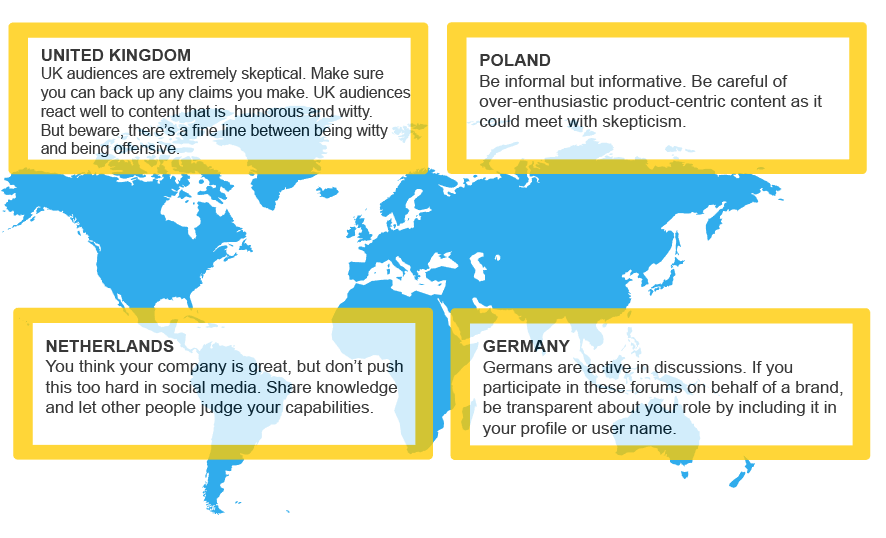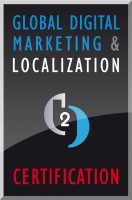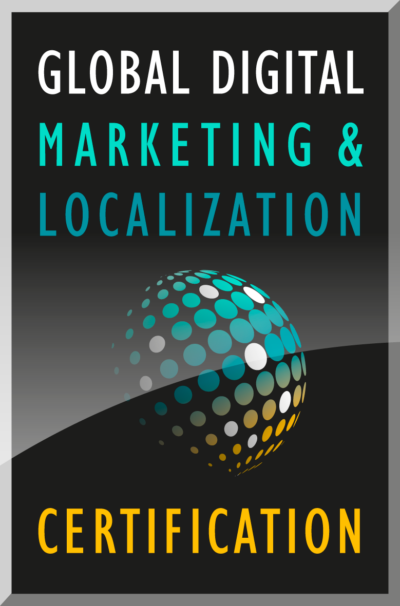This is a paper presented by Monica Rodriguez, a recent graduate of the Global Digital Marketing and Localization Certification (GDMLC) program. This paper presents the work being produced by students of The Localization Institute’s Global Digital Marketing and Localization Certificate program. The contents of this Paper are presented to create discussion in the global marketing industry on this topic; the contents of this paper are not to be considered an adopted standard of any kind. This does not represent the official position of Brand2Global Conference, The Localization Institute, or the author’s organization.
Emotional Connection: The Importance of the Voice and Tone in Social Media for Global Growth
When entering a new market or country, it’s important to gain as much brand exposure as possible. Content marketing is a great tool to communicate with the new market; but it’s essential to understand that the content needs to be localized: modifying it to make it usable and easy to understand for a new locale. Taking cultural sensitivity and nuance into account and delivering a clear message in an easily understandable way.
Consistency in the communication is key, in order to maintain the brand’s tone and voice in a way that takes the unique characteristics of the market in question into account. But, what is it brand voice?Brand voice is not just the writing style and creative approach to communications. It’s the foundation for establishing a relationship with audiences and it’s essential to create an emotional connection.
The brand voice is the core of the global brand experience and nurtures the connection between brand and audience needed in each market, but carries the added degree of difficulty of being dependent on each local language. By establishing the right emotional connection, brands can expect specific emotional and behavioral responses. This is how the relationship begins.
Emotional Connection Through Social Media
One of the most powerful tools to emotionally cultivate the brand voice with the target audience is social media. We build relationships with brands like we build relationships with our friends. It takes many positive interactions over a period of time. Connecting with a brand works much the same way and content delivered by social media is a great enabler for this process.
It’s important to align the company’s tone and voice in social media to avoid chaos and therefore achieve authentic communication. But what kind of voice and tone should we use when reaching different countries? Which factors play a role when defining the way we communicate in Social Media with different cultures? To answer these questions, I’d like to refer to 2 of the 4 dimensions of culture from the model of Professor Geert Hofstede: Individualism versus Collectivism and Masculinity versus Femininity.
Dimensions of Culture
An individualistic culture will put the emphasis on viewing the world like the “I” is more important than the “We”. A collectivistic culture will put the emphasis on putting the group before the individual. The Masculinity side of this dimension represents a preference in society for achievement, heroism, assertiveness and material rewards for success. Society at large is more competitive. Its opposite, femininity, stands for a preference for cooperation, modesty, caring for the weak and quality of life. Society at large is more consensus-oriented. In the business context Masculinity versus Femininity is sometimes also related to as “tough versus tender” cultures.
There are enormous differences in cultural dimensions between countries. For instance, United States has a high score in individualism and masculinity, which means that the communication with this audience should put emphasis on the individual before the group and highlight assertiveness, achieving or success. While the communication with the audience in Brazil, which is high in collectivism and femininity, should emphasize the community, family, friends, and be caring and modest.
These cultural dimensions give us a path to follow when communicating the brand’s message using the correct tone and voice through social media to reach different countries.
Perfect Formula: Transcreation + Tone and Voice= Emotional Engagement
If we want to “talk” to our audience in Brazil and the content is in English, we need to be careful because literal translation is not experienced in the same way in different markets. Transcreation, in the other hand, can help reach in an emotional level the intended audience. Transcreation blends translation with cultural and linguistic nuances. A mix between transcreation and the right tone and voice could result in emotional content that conveys the same concept in the context of local preferences.
On example is Mercola.com, a website that provides health articles, optimal wellness products and medical news. Last year, Mercola.com launched its website in 7 different languages, French, Portuguese, Russian, Chinese, Korean and Japanese, in order to globalize the brand and reach an international audience.
Mercola.com uses content as a marketing tool, and social media as a channel to communicate and engage with its target audience. In the images below, we can see the same article written in English and transcreated to Portuguese, in addition to the difference in the use of images, the way the brand addresses the reader is different.
In Portuguese (top), the brand looks to engage with Brazilian readers, for that reason the post is written in a friendly, caring, and explanatory tone; Brazilians are friendly people and they trust their friends’ recommendations hence the brand is looking to connect with the reader in that way. Whereas the post in English (bottom) is simple, assertive and to the point. The brand voice (style, personality) is the same but it varies in the tone (attitude) accordingly with the targeted culture.
The result is a high engagement in both audiences; Americans know they can trust the clear and easy to read tone and voice of Mercola.com and Brazilians trust the friendly and caring voice of the brand.
Below, the marketing firm LEWIS (Figure 2) created a map with some tips to address international audiences in social media:

Figure 2 Based on: What you should know about social media around the world, The Global Social MEDIA Challenge (LEWIS Whitepaper)
Brand Voice Consistency
Whether the brand has a centralized team who is in charge of global reach from the headquarters or it has teams in each country, it’s essential to define voice consistency in terms of the desired impact; i.e. emotional response, and outcomes like behavioral response. Once defined, we should allow flexibility in social media to ensure a relevant expression.
Did It Work?
When measuring the effectiveness of the communication, we should measure both global consistency and local relevance. We need to see the level at which the brand is succeeding in customizing the message, and assess the efficacy by examining audience responses to the brand voice and tone in the market.
By looking at the audience responses, we can evaluate the effectiveness of the content in that language and validate whether the brand is executing on the voice and tone, and building the right relationship globally.
The power of brand voice for global impact means thinking more holistically about how it is created, managed, and measured. Voice needs to be defined in terms of creative style and the connection it aims to create. This becomes the foundation that must be taken into account to effectively execute the voice and tone at the local level. Only then we can achieve the right experience to engage with audiences and evoke the desired emotional and behavioral response.
Author Bio:
Connect with Monica:
 If you are interested in learning more about the Global Digital Marketing and Localization Certification please click here. The program offers dual credentials, with a Certificate from the University of North Carolina Wilmington and a Certification from The Localization Institute. Monica’s feedback on the course:
If you are interested in learning more about the Global Digital Marketing and Localization Certification please click here. The program offers dual credentials, with a Certificate from the University of North Carolina Wilmington and a Certification from The Localization Institute. Monica’s feedback on the course:
I have to say that it was a pleasure to take the course, the information you provide is excellent. I learned a lot!
References:
Henderson, F. 2016. Need to Know: Localizing Your Social Accounts for Your Marketing Communication Strategy https://rubric.com/en-US/need-know-localizing-social-accounts-marketing-communication-strategy/
Gray, F. A Global Voice for Global Growth
http://interbrand.com/views/brand-heard-round-the-world-a-new-approach-to-global-voice/
Businessesgrow. 2014. Four ways social media impacts emotional branding
https://www.businessesgrow.com/2014/11/03/emotional-branding/
Lee, K. 2014. The Best Examples, Questions, And Guides To Find Your Social Media Marketing Voice
Ballard, B. Content Marketing: What’s The Difference Between Tone And Voice?
https://written.com/blog/41/content-marketing-whats-difference-tone-voice
Smith, C. 2012. Social Media in Different Cultures or Social Media and Culture
https://culturematters.com/social-media-in-different-cultures-or-social-media-and-culture/
Smith, C. 2012. What is Individualism?
https://culturematters.com/what-is-individualism/
Hofstede, G. National Culture
https://geert-hofstede.com/national-culture.html
Lionbridge. 2014. Why Transcreation Is Needed For Creative Marketing Content
http://content.lionbridge.com/use-transcreation-global-marketing-pr-content/
Disclaimer













